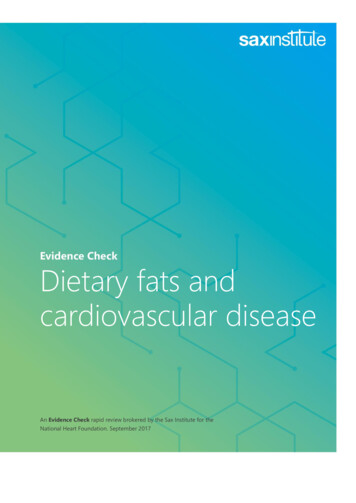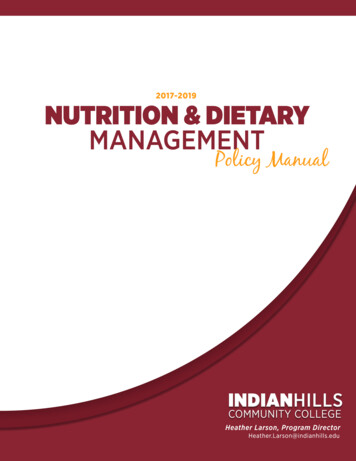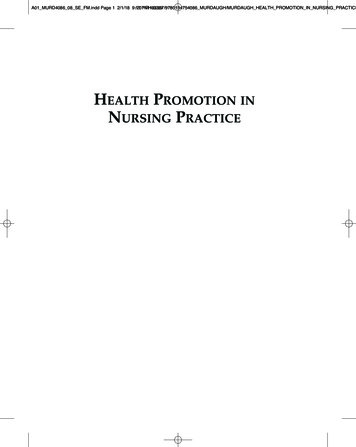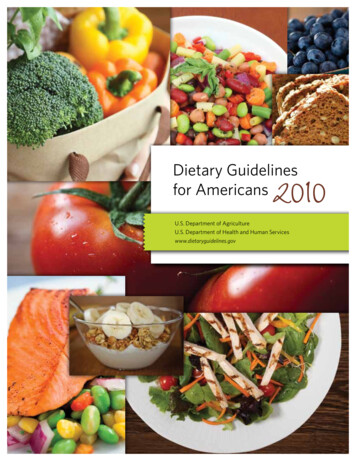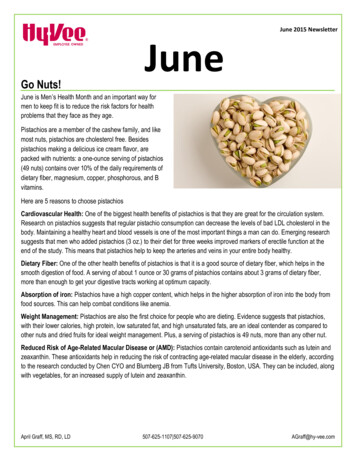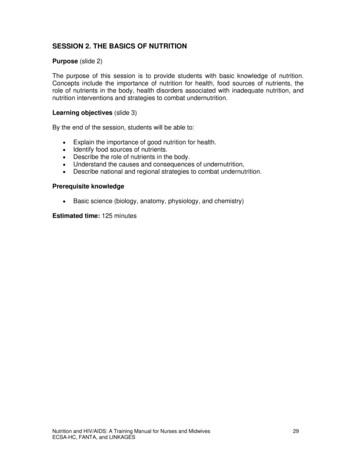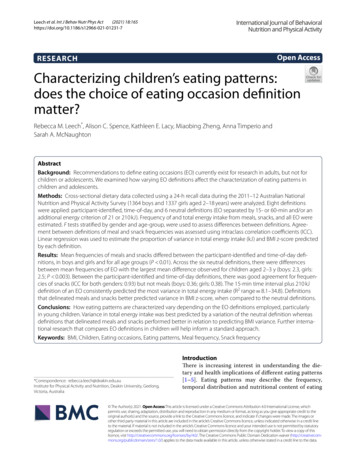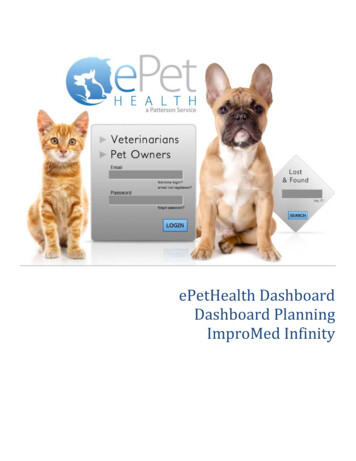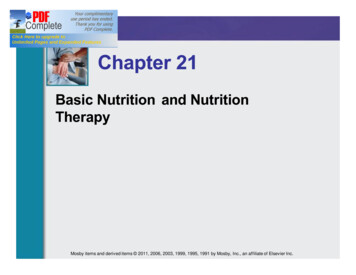
Transcription
Nutrition and Your Health:DIETARY GUIDELINES FOR AMERICANS.for good health
DIETARY GUIDELINES FOR AMERICANSAIM FOR FITNESS. Aim for a healthy weight. Be physically active each day.BUILD A HEALTHY BASE. Let the Pyramid guide your foodchoices. Choose a variety of grains daily,especially whole grains. Choose a variety of fruits andvegetables daily. Keep food safe to eat.CHOOSE SENSIBLY. Choose a diet that is low in saturatedfat and cholesterol and moderate intotal fat. Choose beverages and foods tomoderate your intake of sugars. Choose and prepare foods withless salt. If you drink alcoholic beverages,do so in moderation.for good health
ContentsAim Build Choose for Good Health . . . . . . . . . . . . . . . . . . . . . . . . page 2Aim for FitnessAim for a healthy weight. . . . . . . . . . . . . . . . . . . . . . . . . . . . . . . . . . . . . . . . . . . . . . page 6Be physically active each day . . . . . . . . . . . . . . . . . . . . . . . . . . . . . . . . . . . . . . . . . page 10Build a Healthy BaseLet the Pyramid guide your food choices . . . . . . . . . . . . . . . . . . . . . . . . . . . . . . . page 14Choose a variety of grains daily, especially whole grains . . . . . . . . . . . . . . . . . . . page 20Choose a variety of fruits and vegetables daily . . . . . . . . . . . . . . . . . . . . . . . . . . . page 22Keep food safe to eat . . . . . . . . . . . . . . . . . . . . . . . . . . . . . . . . . . . . . . . . . . . . . . . . page 24Choose SensiblyChoose a diet that is low in saturated fat andcholesterol and moderate in total fat. . . . . . . . . . . . . . . . . . . . . . . . . . . . . . . . . . . page 28Choose beverages and foods to moderate your intake of sugars . . . . . . . . . . . . . page 32Choose and prepare foods with less salt . . . . . . . . . . . . . . . . . . . . . . . . . . . . . . . . page 34If you drink alcoholic beverages, do so in moderation . . . . . . . . . . . . . . . . . . . . . page 36Acknowledgments . . . . . . . . . . . . . . . . . . . . . . . . . . . . . . . . . . . . . . . . . . . . . . . . . . . page 38For Additional Information on Nutrition . . . . . . . . . . . . . . . . . . . . . . . . . . . . . . . . . . page 39Dietary Guidelines for Americans, 20001
Aim Build Choose .for Good Healthating is one of life’s greatest pleasures. Since thereare many foods and many ways to build a healthydiet and lifestyle, there is lots of room for choice. Usethis booklet to help you and your family find ways toenjoy food while taking action for good health.Build a healthy baseThis booklet carries three basic messages—the ABC’sfor your health and that of your family:E2AAim for fitness.BBuild a healthy base.CChoose sensibly.Ten guidelines point the way to good health. Theseguidelines are intended for healthy children (ages 2years and older) and adults of any age.Aim for fitness Aim for a healthy weight. Be physically active each day.Following these two guidelines will help keep you andyour family healthy and fit. Healthy eating and regularphysical activity enable people of all ages to workproductively, enjoy life, and feel their best. They alsohelp children grow, develop, and do well in school. Let the Pyramid guide your food choices. Choose a variety of grains daily, especiallywhole grains. Choose a variety of fruits and vegetables daily. Keep food safe to eat.Following these four guidelines builds a base forhealthy eating. Let the Food Guide Pyramid guide youso that you get the nutrients your body needs each day.Make grains, fruits, and vegetables the foundation ofyour meals. This forms a base for good nutrition andgood health and may reduce your risk of certainchronic diseases. Be flexible and adventurous—try newchoices from these three groups in place of some lessnutritious or higher calorie foods you usually eat.Whatever you eat, always take steps to keep your foodsafe to eat.Choose sensibly Choose a diet that is low in saturated fat andcholesterol and moderate in total fat. Choose beverages and foods to moderate yourintake of sugars. Choose and prepare foods with less salt. If you drink alcoholic beverages, do so inmoderation.Dietary Guidelines for Americans, 2000
These four guidelines help you make sensible choicesthat promote health and reduce the risk of certainchronic diseases. You can enjoy all foods as part of ahealthy diet as long as you don’t overdo it on fat(especially saturated fat), sugars, salt, and alcohol. Readlabels to identify foods that are higher in saturated fats,sugars, and salt (sodium).Together, the 10 guidelines in this booklet will help youbuild healthful eating patterns and take action for goodhealth. This booklet tells you the reason each guidelineis important and gives tips for following the guidelines.Use this booklet to find out some of the many ways toaim for fitness, to build a healthy base, and to choosesensibly.Aim, Build, Choose—for Good HealthBy following all of the guidelines in this booklet, youcan promote your health and reduce your risk forchronic diseases such as heart disease, certain types ofcancer, diabetes, stroke, and osteoporosis. Thesediseases are leading causes of death and disabilityamong Americans. Good diets can also reduce majorrisk factors for chronic disease—such as obesity, highblood pressure, and high blood cholesterol. Your foodchoices, your lifestyle, your environment, and yourfamily history all affect your well-being. It is importantfor everyone to follow the 10 Dietary Guidelines in thisbooklet. If you are at higher risk for a chronic disease, itis especially important. So find out your family historyof disease and your other risk factors for disease (seebox 2) to make more informed decisions about how toimprove your health.Dietary Guidelines for Americans, 20003
Aim for a healthy weight Be physically active eachday
Aim for a healthy weightChoose a lifestyle that combines sensible eating withregular physical activity. To be at their best, adultsneed to avoid gaining weight, and many need to loseweight. Being overweight or obese increases your riskfor high blood pressure, high blood cholesterol, heartdisease, stroke, diabetes, certain types of cancer,arthritis, and breathing problems. A healthy weight iskey to a long, healthy life.6Evaluate your body weightFor adults and children, different methods are used tofind out if weight is about right for height. If you haveconcerns about your child’s body size, talk with yourhealth care provider. Also see the section Encouragehealthy weight in children on page 9.Keep track of your weight and your waistmeasurement, and take action if either of themincreases. If your BMI is greater than 25, or even if itis in the “healthy” range, at least try to avoid furtherweight gain. If your waist measurement increases, youare probably gaining fat. If so, take steps to eat fewercalories and become more active.Box 1HOW TO EVALUATE YOURWEIGHT (ADULTS)1. Weigh yourself and have your height measured.Find your BMI category in figure 1. The higheryour BMI category, the greater the risk forhealth problems.If you are an adult, follow the directions in box 1 toevaluate your weight in relation to your height, or BodyMass Index (BMI). Not all adults who have a BMI in therange labeled “healthy” are at their most healthyweight. For example, some may have lots of fat andlittle muscle. A BMI above the healthy range is lesshealthy for most people; but it may be fine if you havelots of muscle and little fat. The further your BMI isabove the healthy range, the higher your weight-relatedrisk (see figure 1). If your BMI is above the healthyrange, you may benefit from weight loss, especially ifyou have other health risk factors (see box 2).2. Measure around your waist, just above your hipbones, while standing. Health risks increase aswaist measurement increases, particularly ifwaist is greater than 35 inches for women or 40inches for men. Excess abdominal fat may placeyou at greater risk of health problems, even ifyour BMI is about right.BMI’s slightly below the healthy range may still behealthy unless they result from illness. If your BMI isbelow the healthy range, you may have increased risk ofmenstrual irregularity, infertility, and osteoporosis. Ifyou lose weight suddenly or for unknown reasons, see ahealth care provider. Unexplained weight loss may bean early clue to a health problem.NOTE: Weight loss is usually not advisable for pregnant women.3. Use box 2 to find out how many other riskfactors you have.The higher your BMI and waist measurement, andthe more risk factors you have from box 2, the moreyou are likely to benefit from weight loss.Dietary Guidelines for Americans, 2000
Aim for FitnessFigure 1ARE YOU AT A HEALTHY WEIGHT?2530.5BMI (Body Mass '10"5075100125150175Pounds†200225250275*Without shoes. †Without clothes.BMI measures weight in relation to height. The BMI ranges shown above are for adults. They are not exactranges of healthy and unhealthy weights. However, they show that health risk increases at higher levels ofoverweight and obesity. Even within the healthy BMI range, weight gains can carry health risks for adults.Directions: Find your weight on the bottom of the graph. Go straight up from that point until you cometo the line that matches your height. Then look to find your weight group.Healthy Weight BMI from 18.5 up to 25 refers to healthy weight.Overweight BMI from 25 up to 30 refers to overweight.Obese BMI 30 or higher refers to obesity. Obese persons are also overweight.Source: Report of the Dietary Guidelines Advisory Committee on the Dietary Guidelines for Americans, 2000, page 3.Dietary Guidelines for Americans, 2000
Aim for FitnessBox 2FIND OUT YOUR OTHER RISKFACTORS FOR CHRONIC DISEASEThe more of these risk factors you have, the moreyou are likely to benefit from weight loss if you areoverweight or obese. Do you have a personal or family history ofheart disease? Are you a male older than 45 years or apostmenopausal female? Do you smoke cigarettes? Do you have a sedentary lifestyle? Has your doctor told you that you have- high blood pressure?- abnormal blood lipids (high LDL cholesterol,low HDL cholesterol, high triglycerides)?8- diabetes?Try to be more active throughout the day. The physicalactivity guideline (see page 10) recommends that alladults get at least 30 minutes of moderate physicalactivity most or preferably all days of the week. Tomaintain a healthy weight after weight loss, adults willlikely need to do more than 30 minutes of moderatephysical activity daily. Over time, even a small decreasein calories eaten and a small increase in physicalactivity can keep you from gaining weight or help youlose weight.Box 3CHOOSE SENSIBLE PORTION SIZESControl portion size. See guideline “Let the Pyramidguide your food choices” on pages 14-15 forsensible sizes and numbers of servings. If you’re eating out, choose small portion sizes,share an entree with a friend, or take part of thefood home (if you can chill it right away). Check product labels to learn how much foodis considered to be a serving, and how manycalories, grams of fat, and so forth are in thefood. Many items sold as single portionsactually provide 2 servings or more. Examplesinclude a 20-ounce container of soft drink, a12-ounce steak, a 3-ounce bag of chips, anda large bagel. Be especially careful to limit portion size offoods high in calories, such as cookies, cakes,other sweets, French fries, and fats, oils, andspreads.Manage your weightOur genes affect our tendency to gain weight. Atendency to gain weight is increased when food isplentiful and when we use equipment and vehicles tosave time and energy. However, it is possible to manageyour weight through balancing the calories you eatwith your physical activity choices.To make it easier to manage your weight, make longterm changes in your eating behavior and physicalactivity. To do this, build a healthy base and makesensible choices. Choose a healthful assortment offoods that includes vegetables, fruits, grains (especiallywhole grains), skim milk, and fish, lean meat, poultry,or beans. Choose foods that are low in fat and addedsugars (see pages 28-33) most of the time. Whateverthe food, eat a sensible portion size (see box 3).The carbohydrates, fats, and proteins in food supplyenergy, which is measured in calories. High-fat foodscontain more calories than the same amount of otherfoods, so they can make it difficult for you to avoidexcess calories. However, low fat doesn’t always meanlow calorie. Sometimes extra sugars are added to lowfat muffins or desserts, for example, and they may bejust as high in calories.Dietary Guidelines for Americans, 2000
Aim for FitnessYour pattern of eating may be important. Snacks andmeals eaten away from home provide a large part ofdaily calories for many people. Choose them wisely. Tryfruits, vegetables, whole grain foods, or a cup of low-fatmilk or yogurt for a snack. When eating out, choosesmall portions of foods. If you choose fish, poultry, orlean meat, ask that it be grilled rather than fried.Like younger adults, overweight and obese older adultsmay improve their health by losing weight. Theguidance of a health care provider is recommended,especially for obese children and older adults. Sinceolder people tend to lose muscle mass, regular physicalactivity is a valuable part of a weight-loss plan. Buildingor maintaining muscle helps keep older adults activeand reduces their risk of falls and fractures. Stayingactive throughout your adult years helps maintainmuscle mass and bone strength for your later years.If you need to lose weight, do sograduallyIf you are overweight, loss of 5 to 15 percent of yourbody weight may improve your health, ability tofunction, and quality of life. Aim to lose about 10percent of your weight over about 6 months. Thiswould be 20 pounds of weight loss for someone whoweighs 200 pounds. Loss of 1/2 to 2 pounds per week isusually safe. Even if you have regained weight in thepast, it’s worthwhile to try again.Help children to develop healthy eating habits. Makesmall changes. For example, serve low-fat milk ratherthan whole milk and offer one cookie instead of two.Since children still need to grow, weight loss is notrecommended unless guided by a health care provider.Serious eating disordersFrequent binge eating, with or without periods of foodrestriction, may be a sign of a serious eating disorder.Other signs of eating disorders include preoccupationwith body weight or food (or both—regardless of bodyweight), dramatic weight loss, excessive exercise, selfinduced vomiting, and the abuse of laxatives. Seek helpfrom a health care provider if any of these apply to you,a family member, or a friend.A D V I C E F O R T O D AY Aim for a healthy weight. If you are at a healthyweight, aim to avoid weight gain. If you are alreadyoverweight, first aim to prevent further weightgain, and then lose weight to improve your health. Build a healthy base by eating vegetables, fruits, andgrains (especially whole grains) with little added fator sugar. Select sensible portion sizes. Get moving. Get regular physical activity to balancecalories from the foods you eat.Encourage healthy weight in childrenChildren need enough food for proper growth, but toomany calories and too little physical activity lead tooverweight. The number of overweight U.S. childrenhas risen dramatically in recent years. Encouragehealthy weight by offering children grain products;vegetables and fruits; low-fat dairy products; and beans,lean meat, poultry, fish, or nuts—and let them see youenjoy eating the same foods. Let the child decide howmuch of these foods to eat. Offer only small amounts offood high in fat or added sugars. Encourage children totake part in vigorous activities (and join themwhenever possible). Limit the time they spend insedentary activities like watching television or playingcomputer or video games. Set a good example for children by practicinghealthy eating habits and enjoying regular physicalactivities together. Keep in mind that even though heredity and theenvironment are important influences, yourbehaviors help determine your body weight.Dietary Guidelines for Americans, 20009
Be physically active each dayBeing physically active and maintaining a healthyweight are both needed for good health, but theybenefit health in different ways. Children, teens,adults, and the elderly—all can improve their healthand well-being and have fun by including moderateamounts of physical activity in their daily lives.Physical activity involves moving the body. A moderatephysical activity is any activity that requires about asmuch energy as walking 2 miles in 30 minutes.10Aim to accumulate at least 30 minutes (adults) or 60minutes (children) of moderate physical activity mostdays of the week, preferably daily. If you already get 30minutes of physical activity daily, you can gain evenmore health benefits by increasing the amount of timethat you are physically active or by taking part in morevigorous activities. No matter what activity you choose,you can do it all at once, or spread it out over two orthree times during the day.Make physical activity a regular part ofyour routineChoose activities that you enjoy and that you can doregularly (see box 4). Some people prefer activities thatfit into their daily routine, like gardening or takingextra trips up and down stairs. Others prefer a regularexercise program, such as a physical activity programat their worksite. Some do both. The important thing isto be physically active every day.Most adults do not need to see their health careprovider before starting to become more physicallyactive. However, if you are planning to start a vigorousactivity plan and have one or more of the conditionsbelow, consult your health care provider: Chronic health problem such as heart disease,hypertension, diabetes, osteoporosis, or obesity. High risk for heart disease (see box 2). Over age 40 for men or 50 for women.Health benefits of physical activityCompared with being very sedentary, being physicallyactive for at least 30 minutes on most days of the weekreduces the risk of developing or dying of heart disease.It has other health benefits as well (see box 5). No one istoo young or too old to enjoy the benefits of regularphysical activity.Two types of physical activity are especially beneficial: Aerobic activities. These are activities that speedyour heart rate and breathing. They helpcardiovascular fitness. Activities for strength and flexibility. Developingstrength may help build and maintain your bones.Carrying groceries and lifting weights are twostrength-building activities. Gentle stretching,dancing, or yoga can increase flexibility.To get these health benefits, adults need moderatephysical activity for a total of at least 30 minutes mostdays of the week, preferably daily, and children need atleast 60 minutes per day.Dietary Guidelines for Americans, 2000
Aim for FitnessBox 4Box 5EXAMPLES OF PHYSICALACTIVITIES FOR ADULTSHEALTH BENEFITS OF REGULARPHYSICAL ACTIVITYFor at least 30 minutes most days of the week,preferably daily, do any one of the activities listedbelow—or combine activities. Look for additionalopportunities among other activities that you enjoy. Increases physical fitness Helps build and maintain healthy bones,muscles, and joints Builds endurance and muscular strength Helps manage weight Lowers risk factors for cardiovascular disease,colon cancer, and type 2 diabetes Helps control blood pressure Promotes psychological well-being andself-esteem Reduces feelings of depression and anxietyAs part of your routine activities: Walk, wheel, or bike ride more, drive less. Walk up stairs instead of taking an elevator. Get off the bus a few stops early and walk orwheel the remaining distance. Mow the lawn with a push mower. Rake leaves. Garden. Push a stroller. Clean the house. Do exercises or pedal a stationary bike whilewatching television. Play actively with children. Take a brisk 10-minute walk or wheel in themorning, at lunch, and after dinner.As part of your exercise or recreational routine: Walk, wheel, or jog. Bicycle or use an arm pedal bicycle. Swim or do water aerobics. Play racket or wheelchair sports. Golf (pull cart or carry clubs). Canoe. Cross-country ski. Play basketball. Dance. Take part in an exercise program at work,home, school, or gym.Physical activity and nutritionPhysical activity and nutrition work together for betterhealth. For example, physical activity increases theamount of calories you use. For those who haveintentionally lost weight, being active makes it easierto maintain the weight loss. However, 30 minutes ofactivity daily may not be enough to lose weight ormaintain weight loss. Read the preceding guideline“Aim for a Healthy Weight,” for more informationabout weight management.Physical activity and nutrition work together in moreways than weight management. Increasing the caloriesyou use allows you to eat more, which makes it easierto get the nutrients you need. Physical activity andnutrition work together for bone health, too. Calciumand other nutrients are needed to build and maintainstrong bones, but physical activity is needed as well.Dietary Guidelines for Americans, 200011
Aim for FitnessHelp children be physically activeChildren and adolescents benefit from physical activityin many ways. They need at least 60 minutes of physicalactivity daily (see box 6). Parents can help: Set a good example. For example, arrange activefamily events in which everyone takes part. Joinyour children in physical activities. Encourage your children to be physically active athome, at school, and with friends by jumping rope,playing tag, riding a bike. Limit television watching, computer games, andother inactive forms of play by alternating withperiods of physical activity.Older persons also need to be physically active. Engagein moderate physical activity for at least 30 minutesmost days of the week, preferably daily, and take partin activities to strengthen muscles and to improveflexibility. Staying strong and flexible can reduce yourrisk of falling and breaking bones, preserve muscle, andimprove your ability to live independently. Lifting smallweights and carrying groceries are two ways to includestrength building into your routine.A D V I C E F O R T O D AY Engage in at least 30 minutes (adults) or 60minutes (children) of moderate physical activitymost, preferably all, days of the week.Box 612Older people need to be physicallyactive tooPHYSICAL ACTIVITIES FORCHILDREN AND TEENSAim for at least 60 minutes total per day: Be spontaneously active. Play tag. Jump rope. Ride a bicycle or tricycle. Walk, wheel, skip, or run. Play actively during school recess. Roller skate or in-line skate. Take part in physical education activity classesduring school. Join after-school or community physical activityprograms. Dance. Become physically active if you are inactive. Maintain or increase physical activity if you arealready active. Stay active throughout your life. Help children get at least 60 minutes of physicalactivity daily. Choose physical activities that fit in with your dailyroutine, or choose recreational or structuredexercise programs, or both. Consult your health care provider before startinga new vigorous physical activity plan if you have achronic health problem, or if you are over 40 (men)or 50 (women).Dietary Guidelines for Americans, 2000
Let the Pyramid guide yourfood choices Choose a variety of grainsdaily, especially wholegrains Choose a variety of fruitsand vegetables daily Keep food safe to eat
Let the Pyramid guideyour food choicesDifferent foods contain different nutrients and otherhealthful substances. No single food can supply allthe nutrients in the amounts you need. For example,oranges provide vitamin C and folate but no vitaminB12; cheese provides calcium and vitamin B12 but novitamin C. To make sure you get all the nutrients andother substances you need for health, build a healthybase by using the Food Guide Pyramid (figure 2) as astarting point. Choose the recommended number ofdaily servings from each of the five major food groups(box 7). If you avoid all foods from any of the five foodgroups, seek guidance to help ensure that you get allthe nutrients you need.Box 714HOW MANY SERVINGS DO YOU NEED EACH DAY?Children ages 2to 6 years, women,some older adults(about 1,600calories)Older children,teen girls, activewomen, most men(about 2,200calories)Teen boys,active men(about 2,800calories)Bread, Cereal, Rice,and Pasta Group(Grains Group)—especially whole grain6911Vegetable Group345Fruit Group234Milk, Yogurt, and CheeseGroup (Milk Group)—preferably fat freeor low fat2 or 3*2 or 3*2 or 3*Meat, Poultry, Fish,Dry Beans, Eggs, andNuts Group (Meat andBeans Group)—preferablylean or low fat2, for a totalof 5 ounces2, for a totalof 6 ounces3, for a totalof 7 ouncesFood groupAdapted from U.S. Department of Agriculture, Center for NutritionPolicy and Promotion. The Food Guide Pyramid, Home and GardenBulletin Number 252, 1996.* The number of servings depends on your age. Older children andteenagers (ages 9 to 18 years) and adults over the age of 50 need3 servings daily. Others need 2 servings daily. During pregnancyand lactation, the recommended number of milk group servings isthe same as for nonpregnant women.Dietary Guidelines for Americans, 2000
Build a Healthy BaseFigure 2Food Guide PyramidA Guide to Daily Food ChoicesFats, Oils, & SweetsUSE SPARINGLYKEYFat (naturally occurringand added)Sugars(added)These symbols show fat andadded sugars in foods.Milk, Yogurt,& CheeseGroup2-3 SERVINGSMeat, Poultry, Fish,Dry Beans, Eggs,& Nuts Group2-3 SERVINGSVegetableGroup3-5 SERVINGSFruitGroup2-4 SERVINGSBread, Cereal,Rice, & PastaGroup6-11SERVINGSSource: U.S. Department of Agriculture/U.S. Department of Health and Human ServicesBox 8WHAT COUNTS AS A SERVING?Bread, Cereal, Rice, and Pasta Group(Grains Group)—whole grain and refined 1 slice of breadAbout 1 cup of ready-to-eat cereal1/2 cup of cooked cereal, rice, or pastaVegetable Group 1 cup of raw leafy vegetables1/2 cup of other vegetables—cooked or raw3/4 cup of vegetable juiceMilk, Yogurt, and Cheese Group (Milk Group)* Meat, Poultry, Fish, Dry Beans, Eggs, andNuts Group (Meat and Beans Group) Fruit Group 1 medium apple, banana, orange, pear1/2 cup of chopped, cooked, or canned fruit3/4 cup of fruit juiceNOTE: Many of the serving sizes given above are smaller than thoseon the Nutrition Facts Label. For example, 1 serving of cookedcereal, rice, or pasta is 1 cup for the label but only 1/2 cup for thePyramid.* This includes lactose-free and lactose-reduced milk products. Onecup of soy-based beverage with added calcium is an option forthose who prefer a non-dairy source of calcium.1 cup of milk** or yogurt**1 1/2 ounces of natural cheese** (such asCheddar)2 ounces of processed cheese** (such as American)2–3 ounces of cooked lean meat, poultry, or fish1/2 cup of cooked dry beans# or 1/2 cup of tofucounts as 1 ounce of lean meat2 1/2-ounce soyburger or 1 egg counts as 1 ounceof lean meat2 tablespoons of peanut butter or 1/3 cup of nutscounts as 1 ounce of meat** Choose fat-free or reduced-fat dairy products most often.#Dry beans, peas, and lentils can be counted as servings ineither the meat and beans group or the vegetable group. As avegetable, 1/2 cup of cooked, dry beans counts as 1 serving. Asa meat substitute, 1 cup of cooked, dry beans counts as 1 serving(2 ounces of meat).Dietary Guidelines for Americans, 200015
Build a Healthy BaseUse plant foods as the foundation ofyour mealsThere are many healthful eatingpatternsThere are many ways to create a healthy eating pattern,but they all start with the three food groups at the baseof the Pyramid: grains, fruits, and vegetables. Eating avariety of grains (especially whole grain foods), fruits,and vegetables is the basis of healthy eating. Enjoymeals that have rice, pasta, tortillas, or whole grainbread at the center of the plate, accompanied by plentyof fruits and vegetables and a moderate amount of lowfat foods from the milk group and the meat and beansgroup. Go easy on foods high in fat or sugars.Different people like different foods and like to preparethe same foods in different ways. Culture, familybackground, religion, moral beliefs, the cost andavailability of food, life experiences, food intolerances,and allergies affect people’s food choices. Use the FoodGuide Pyramid as a starting point to shape your eatingpattern. It provides a good guide to make sure you getenough nutrients. Make choices from each major groupin the Food Guide Pyramid, and combine themhowever you like. For example, those who like Mexicancuisine might choose tortillas from the grains groupand beans from the meat and beans group, while thosewho eat Asian food might choose rice from the grainsgroup and tofu from the meat and beans group.Keep an eye on servings16Compare the recommended number of servings in box7 and the serving sizes in box 8 with what you usuallyeat. If you don’t need many calories (because you’reinactive, for example), aim for the lower number ofservings. Notice that some of the serving sizes in box 8are smaller than what you might usually eat or see onfood labels. For example, many people eat 2 slices ofbread in a meal, which equal 2 servings. So it’s easyto meet the recommended number of servings. Youngchildren 2 to 3 years old need the same number ofservings as others, but smaller serving sizes exceptfor milk.Also notice that many of the meals and snacks you eatcontain items from several food groups. For example, asandwich may provide bread from the grains group,turkey from the meat and beans group, and cheesefrom the milk group.If you usually avoid all foods from one or two of thefood groups, be sure
enjoy food while taking action for good health. This booklet carries three basic messages—the ABC’s for your health and that of your family: A Aim for fitness. B Build a healthy base. C Choose sensibly. Ten guidelines point the way to good health. These guidelines are intended for health
